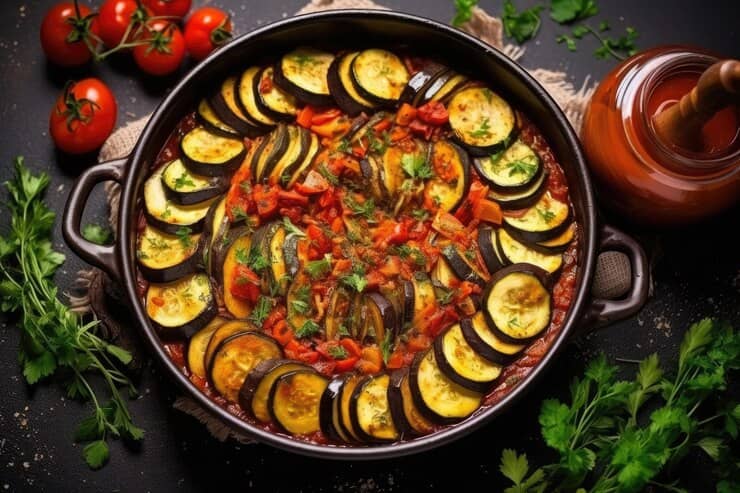Next, add another tablespoon of olive oil and repeat the process with the zucchini. Cook the zucchini until it’s browned and tender, around 5 minutes. Remove and set aside with the eggplant.
3. Caramelize the Onions
Add the last tablespoon of olive oil to the same pan, and cook the onions over medium heat. Stir occasionally for about 10 minutes, allowing the onions to caramelize and develop a sweet, deep flavor.
4. Add the Bell Peppers and Garlic
Once the onions are golden, add the diced bell peppers and garlic slices to the pan. Sauté for another 5 minutes until the peppers begin to soften and the garlic becomes fragrant.
5. Add Tomatoes, Herbs, and Seasoning
Now it’s time to introduce the tomatoes. Add the diced Roma tomatoes, thyme sprigs, and parsley to the pan. Sprinkle the sugar, coarse salt, and cracked black pepper into the mixture. Stir everything together, making sure the tomatoes are well combined with the other vegetables. Let the mixture simmer for 10-12 minutes, allowing the tomatoes to break down and release their juices.
6. Stew the Vegetables Together
Return the seared eggplant and zucchini to the pan, mixing them with the stewed vegetables. Reduce the heat to low and let everything cook together for another 5-6 minutes. This step melds the flavors, creating a rich, savory ratatouille with tender vegetables.
7. Adjust Seasoning and Serve
Taste the ratatouille and adjust the seasoning with more salt, pepper, or red pepper flakes if desired. Remove the thyme sprigs and parsley stems before serving.
You can serve ratatouille hot or cold. It pairs wonderfully with fresh crusty bread, and it can also be served alongside grilled meats, roasted chicken, or fish.
For an extra touch of flavor, garnish with fresh thyme leaves or a sprinkle of crushed red pepper flakes.
Chef’s Tips for the Perfect Ratatouille
- Use Fresh, Quality Vegetables: The key to a delicious ratatouille is starting with the freshest ingredients. If possible, use vegetables that are in season for maximum flavor.
- Searing the Vegetables Separately: Cooking each vegetable individually ensures they retain their unique flavors and textures. This step may take extra time, but it makes a big difference in the final dish.
- Control the Heat: Ratatouille should be simmered gently rather than boiled. High heat can cause the vegetables to lose their structure and turn mushy. A slow, gentle cook will keep them tender while maintaining their shape.
- Herb Substitutions: If you don’t have fresh herbs on hand, dried thyme or basil can be used as substitutes. However, fresh herbs do add a certain brightness to the dish.
- Balance the Flavors: The small amount of sugar added to this recipe helps balance the acidity of the tomatoes and the slight bitterness of the eggplant. It’s a crucial step in creating a well-rounded flavor profile.
- Make It Ahead of Time: Ratatouille is one of those dishes that tastes even better the next day. The flavors continue to develop as the dish sits, so feel free to make it ahead and refrigerate it for later.
Serving Suggestions: How to Enjoy Ratatouille
Ratatouille is incredibly versatile and can be served in various ways:
- As a Main Dish: Serve it with crusty French bread, and you’ve got a light yet satisfying vegetarian meal. A drizzle of olive oil or a sprinkle of fresh herbs can elevate the presentation.
- As a Side Dish: Ratatouille pairs beautifully with roasted chicken, grilled steak, or pan-seared fish. It brings a burst of freshness to heavier, protein-rich dishes.
- As an Appetizer: Serve cold ratatouille on toasted baguette slices as a starter. You can also serve it as a topping for bruschetta.
- In Pasta or Grains: Mix ratatouille with pasta, quinoa, or couscous for a heartier meal. The vegetables create a naturally rich sauce that coats the grains beautifully.
- With Eggs: Add leftover ratatouille to an omelet or serve it as a base for poached eggs. This makes for a delicious and filling breakfast or brunch option.
Make-Ahead and Storage Tips
One of the best things about ratatouille is that it stores exceptionally well.
- Refrigerator: Store ratatouille in an airtight container in the refrigerator for up to 5 days. The flavors will continue to develop, making it even more delicious the next day.
- Freezer: Ratatouille can also be frozen for up to 3 months. To reheat, simply thaw in the fridge overnight and sauté in a bit of oil over medium heat for 3-4 minutes.
Final Thoughts on Ratatouille
Whether you’re looking for a light summer dish or a hearty winter stew, ratatouille is a timeless classic that brings out the best in simple ingredients. Its vibrant colors and rich flavors make it an elegant addition to any meal, and its versatility ensures it can be served in a variety of ways.
Give this authentic ratatouille recipe a try, and let me know how it turns out. Whether you serve it fresh from the stove or chilled the next day, I’m confident it will become a staple in your kitchen!
FAQs
1. Can I make ratatouille ahead of time?
Yes, ratatouille tastes even better when made ahead. You can refrigerate it for up to 5 days, allowing the flavors to meld.
2. Do I need to peel the eggplant for ratatouille?
It’s up to you! Peeling the eggplant can create a smoother texture, but leaving the peel on adds a bit more structure and nutrients.
3. Can I freeze ratatouille?
Yes, ratatouille freezes well for up to 3 months. Just be sure to thaw it in the fridge overnight before reheating.
4. What other vegetables can I add to ratatouille?
You can experiment with other vegetables like mushrooms or carrots. Just make sure they complement the flavors of the traditional ingredients.
5. Is ratatouille a vegan dish?
Yes, this recipe is naturally vegan as it contains only vegetables, olive oil, and herbs.

